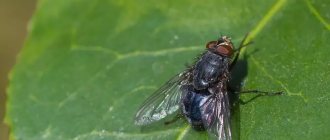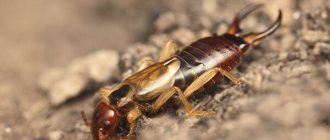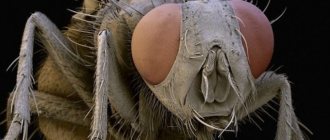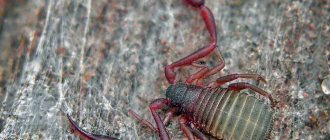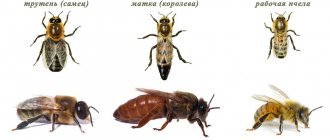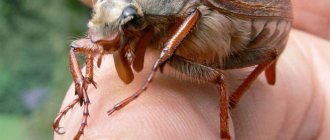The funnel-web spider (also known as grass spider, funnel-web spider, tunnel spider) is an animal from the suborder Opisthothelae, infraorder araneomorphic spiders, family Agelenidae, or funnel-web spiders (lat. Agelenidae). The family includes about 68 genera, including 1,100 species.
The Latin words ago lene, from which the name of the family comes, are translated as “to act timidly”, “to move vaguely”. Spiders received this name for their special intermittent way of running. They stop, freeze and start chasing again, unlike spiders of other families that make smooth continuous dashes. Funnel spiders were named for the shape of their web. Another name, grass spiders, was given to them for their preference to settle in clearings among the grass.
Photo credit: Christian Ferrer, CC BY-SA 4.0
Funnel spider (grass spider) - description and photographs
These are medium-sized spiders: from 6 to 21 mm in leg span, with an oval abdomen and a pear-shaped or ovoid unflattened carapace (dorsal part of the shell). Females are larger than males, but the carapace of many males is larger than that of females.
The funnel web spider's body color ranges from light brown or beige-brown to black. The body is covered with feathery hairs. Most agelenid species have a pattern on the abdomen and carapace. The front pair of legs is always longer than the others. The legs themselves are covered with powerful spines and sensilla. The paws of the legs are equipped with three claws, which indicates the ability of funnelworms to weave webs. The claws are covered with spines, the number and location of which serves as a taxonomic feature.
Photo credit: Donald Hobern, CC BY 2.0
Representatives of the family have 6 simple and 2 complicated eyes. They are approximately equal in size and are usually located in pairs at almost the same distance from each other. Tunnel spiders have poor vision, so they navigate more using their sense of touch (motion sensors on their front legs). The chelicerae are powerful and directed downwards.
On the underside of the abdomen there are 2 pairs of arachnoid warts, the front ones are widely spaced, and the rear ones are elongated and often protrude backwards, resembling tails. One straight spiracle opens in front of the arachnoid warts. Funnel web spiders breathe with the help of two lungs and a pair of tracheas.
Photo credit: Donald Hobern, CC BY 2.0
What do funnel web spiders eat?
Grass spiders weave a horizontal dense web that converges downward in the form of a funnel. The network is supported by vertical support threads. The web of these predators is not sticky, but loose: small insects caught in it get stuck in it and cannot get out. The horizontal upper network turns into a hidden lower one, which in turn transforms into the spider’s refuge - a tube enveloping the burrow. In it, the spider waits for a signal from the catching net, after which it abruptly runs head first (which is typical for stray spiders) and bites the victim. He takes the caught prey into his tube and eats it there, or rather sucks it out.
Photo credit: Apdency, Public Domain
Spiders catch and bite only moving animals. If the victim caught in the web freezes and does not move, the funnel web spider will provoke it by tugging at the web, wait patiently, but will not touch it. Some agelenids may lack a cloth, but all have a living tube (burrow). The webs quickly become clogged with dust, and therefore the spider does not stay in one place for long. After 2-3 weeks, he changes his place of residence and weaves new networks. Funnel web spiders are mainly active at night; only representatives of the genus Malthonica hunt both day and night.
Funnel web spiders feed on a variety of arthropods, sometimes even dangerous to them. In addition to softly chitinized flies, mosquitoes, leafhoppers and small spiders, they catch honey bees, orthoptera, beetles and ants. When a prey gets caught in a web, the owner instantly runs out, moving along the web, and inserts chelicerae into the body of the prey. At the ends of the chelicerae on the claw, glands open, which inject poison and enzymes into the body: they turn the insides of the victim into liquid porridge. Grass spiders do not put the victim in their mouth for better digestion, they simply suck out the already dissolved entrails, waiting for the enzymes to finish their work.
Photo credit: Andy Murray, CC BY-SA 2.0
Reproduction of funnel web spiders
Agelenids breeding time occurs in the midst of summer. The funnel web spider finds the female's nest and taps her web in a specific manner. The female falls into a stupor (trance), the partner takes her to the desired place and mates with her. After this, the couple lives together for several weeks. Then the female will definitely try to eat the male.
By the end of summer, the female will spin a cocoon, place it in her tube or a new living chamber nearby and lay eggs in it. House spiders make several small cocoons with eggs hidden in them and hang them on the web.
Photo credit: Père Igor, CC BY-SA 3.0
Types of funnel-web spiders, names and photos
- Labyrinth spider (Agelena labyrinthica) is a typical species of the Agelena family, the body of which, together with the limbs, reaches 13–21 mm in length. The carapace covering the cephalothorax of the arachnid is gray-yellow, red-brown or yellow-brown with two darker concave longitudinal stripes. On the elongated dark brown abdomen of the labyrinth spider there are well-protruding tail-like posterior arachnoid warts. The gray hairs of the abdomen form a herringbone pattern. The legs have no pattern and are dark brown. They have powerful spines and sensilla.
The labyrinth spider is distributed throughout the Palearctic, living in dry, well-lit places: bushes, fields, clearings, meadows, on slopes, near roads, in vegetable gardens and wastelands. It stretches a horizontal dense network with a diameter of 50 cm among grass and bushes, strengthening it with vertical threads. Below he places a small hidden network that turns into a tube: he himself hides in it. The spider covers its living tube with dry leaves. The tube has a curved shape and is open on both sides. On one side she looks at the trapping net, and on the other - at the emergency exit through which the spider escapes in moments of danger.
The predator drags the caught insects inside the tube. Its web is not equipped with sticky threads: victims simply become entangled in the network. In addition, the owner always arrives on time and uses his poisonous glands. In this species of grass spiders, both males and females weave webs of the same shape.
Mating in Agelena labyrinthine occurs in mid-summer. The male comes to the female's web and gives her a signal. After mating, the female can eat the male if he does not have time to escape. Closer to autumn, the female transforms the trapping net into a cocoon and hides it in her shelter or weaves a separate tube for it. The young will spend the winter in it and will come out only in the spring.
Photo credit: Apdency, public domain
- The house spider (lat. Tegenaria domestica ) is a cosmopolitan synanthropic species that lives in people's houses and basements. Those rare individuals that fate rejected from human habitation are forced to settle under the bark of trees, in hollows, in old stumps or under fallen leaves. The house spider spread throughout the world along with humans. The body length of the male excluding legs does not exceed 10 mm, the female is larger in size and can grow up to 15 mm. The color of the teardrop-shaped abdomen of the spider can be beige-brown or yellow with a leopard-like pattern of brown spots. Occasionally the abdomen pattern looks like a herringbone. The male has a darker color tone. The spider's legs are decorated with an ornament in the form of dark rings.
The female house spider weaves a web in the form of a funnel with an area of 3 dm², going to the place where the predator is hiding. These could be dark corners or secluded places. The male tegenaria often makes traps using only single signal threads without a dense funnel. It also happens that the male does not weave a web at all and hunts in the same way as other wandering spiders. The male goes at night to search for a female and food. The house spider cannot store supplies of victims by wrapping them and putting them aside. It eats the caught prey immediately after its insides are dissolved under the action of injected enzymes. The house spider feeds on flies, fruit flies, bed bugs, woodlice larvae, moths, mealybugs and other prey of suitable size. It helps people get rid of harmful insects.
The venom of house tegenaria has been little studied. And although the house spider’s chelicerae are powerful, it rarely manages to bite through human skin. If the spider feels threatened or is caught, it will try to bite, but there have been no cases of infection and poisoning of a person with its venom in history.
In search of a female, the male often climbs into people's sinks and bathtubs and cannot get out. The male finds the female's web, carefully touches it with his feet and waits at the edge. If the female confuses him with the victim, he is always ready to run away. If she doesn’t come out, it means she understood the signal, then the male begins to slowly move millimeter by millimeter towards the living tube. Mating usually occurs for spiders: the male inserts the pedipalp legs into the female's genital opening located on the underside of the abdomen and transfers sperm there. Seminal fluid can be stored by the female for some time; fertilization of the eggs does not occur immediately.
Soon after mating, the female lays eggs in several small cocoons she has twisted and hangs them on her funnel-shaped web.
Photo credit: Magne Flåten, CC BY-SA 3.0
- The giant house spider, the large black house spider (lat. Eratigena atrica, until 2013 had the Latin name Tegenaria duellica) is famous for killing its relatives with whom it has to compete for food. It bites reluctantly, and the bite of this funnel-web spider is safe for humans. When in danger, he prefers to flee.
Giant house spiders live in people's homes in North America, Central Asia, North Africa and Western Europe. Both male and female have the same dark brown color and three light spots on each side of the cephalothorax. There are also individuals in gray and even black shades. On the underside of their abdomen there is a characteristic yellowish pattern. The black house spider is somewhat similar in color to the regular house spider, but its legs, tentacles and abdomen are covered with abundant hairs. Despite the name, this species of funnel-web spider is not the largest in the genus: females reach a length of 18.5 mm, males - 15 mm. The paws can be of different lengths: from 25 to 75 mm.
Initially, the habitat of the giant house spider was caves or dry forests. Often he hid under stones. But now he has moved into people's residential buildings. It lives for 2-3 years and builds funnel-shaped webs, sometimes reaching dimensions of one and a half meters. Males can be found wandering around the apartment from July to October, while females sit in the web and are found all year round.
At least 60 small spiders emerge from the cocoon. They stay together for about a month, but are not social creatures; they hunt separately. After 7-8 molts, they become adults and crawl into their corners. A large black house spider can bite through human skin, the wound may hurt, but the venom of this arachnid is not dangerous to people.
For a long time, the giant house spider held the lead in speed of movement among its classmates. He runs at a speed of 0.53 m/sec. Today, in the Guinness Book of Records for this indicator, it is displaced by arachnids from the phalanx order (lat. Solifugae).
Photo credit: Parent Géry, CC BY-SA 3.0
- Thin Allagelena (lat. Allagelena gracilens) looks like a labyrinth spider and lives in the same places, but is smaller in size and rare in occurrence. The genus name translates as “distinguishable from Agelena.” The length of the body, excluding the legs, reaches 9-11 mm in the female and 5-10 mm in the male. The color of the spider is light gray with brown dots. Light brown, barely noticeable stripes are present on the cephalothorax. Thin, slightly transparent legs are gray or gray-beige in color.
Grass spiders of this species live in Europe, Central Asia, and the Mediterranean basin. They build their network among bushes in sunny, warm places.
Photo credit: NobbiP, CC BY-SA 3.0
- Meadow spider , or American house spider (lat. Eratigena agrestis, formerly Tegenaria agrestis) also has the name hobo spider. The species was first described in 1802 in its native Western Europe. Now it lives in the forests and meadows of Central Europe, North America (USA and Canada) and the black earth strip of Russia.
This spider weaves webs in peat, logs, and near human houses, and leads an active lifestyle, moving very quickly. Females, especially during gestation and protection of young, having no escape route, can attack and bite; they can bite through human skin. Previously, it was said about the strong hemolytic effect of their poison, allegedly causing skin necrosis. This assumption was later refuted. A bite from this species can only cause severe local inflammation.
The American wandering spider does not grow more than 5 cm in length including legs, and by this feature it can be distinguished from the similar but larger Eratigena atrica, which prefers to live in human homes. The body of the meadow spider is beige with a dark brown pattern: on the abdomen in the form of a herringbone, on the cephalothorax in the form of 2 longitudinal lines. The diet of this species includes insects and other arthropods.
Photo credit: Géry PARENT, CC BY-SA 4.0
- The brown hermit spider (lat. Coelotes terrestris) is a small arthropod, the average body length of which, excluding legs, is 9-14 mm (in females) and 7-10 mm (in males). The color of the upper part of its body is light, red-brown with dark gray spots on the cephalothorax and abdomen. The spider is distinguished by the dark color of the abdominal part and the absence of a pattern on the red-brown limbs. In females the abdomen is large, expanding at the back; in males it is small.
This type of funnel-web spider lives in Europe, China and Turkey, in the central and southern part of the USA, and in Australia. It often settles in the moss litter of forests or under the roots of coniferous trees. Less commonly, it inhabits old stumps and weaves a funnel-shaped web about 5 cm wide under tree bark or stones. The brown recluse spider's favorite prey is insects and their larvae: butterflies, beetles, mosquitoes, flies.
Photo credit: Bernard DUPONT, CC BY-SA 2.0
- Tegenaria parietina is a species of funnel web spider that is found in Africa, Europe, Central Asia, Jamaica and Sri Lanka. Lives near humans, weaving webs in the corners of barns, basements and houses.
The average body length of a female excluding legs is 20 mm, of a male – 17 mm. The legs of representatives of this species are 3 times longer than the body. The spider's cephalothorax is yellow, light brown or yellow-brown, and contains a pattern on top in the form of two wavy black or dark brown lines. The edges of the cephalothorax are outlined by a thin stripe of the same color as the lines in the middle. In some individuals these stripes are clearly visible, in others they are barely noticeable. The beige, brown or yellow abdomen of the male is oval, while that of the female is round. The pattern on it may consist of spots of a darker or lighter color, contrasting with the main coat.
Photo credit: Géry PARENT, CC BY-SA 4.0
The most dangerous Australian spiders
Sydney funnel web spider
(Atrax robustus)
The Sydney funnel- web spider ( English name - Sydney funnel-web spider ) has a very strong poison, which is also produced by the spider in large quantities. Add to this the long chelicerae (sharp “fangs” with a canal opening near the tip that removes poison) - all this makes the Sydney funnel-web spider the most dangerous not only in Australia, but perhaps in the world.
Photo: michael doe1, Flickr
The spider is found in the state of New South Wales in forests, as well as in human-inhabited areas, where they dig holes in damp, sheltered places. They can also wander around backyards and sometimes fall into swimming pools, and although people don't encounter them often, these spiders can be quite aggressive if threatened.
Although they are only 1.5 - 3.5 centimeters in size, their chelicerae ("fangs") are longer than those of a brown snake (the second most venomous Australian snake in the world - 1-2 meters long), and are so strong that they can even bite through nails on the fingers and toes. The venom of the Sydney funnel web spider contains a component that acts on the human nervous system and can change the functioning of all organs and, if bitten by a male, can even kill. Typically one in six bites from this spider causes a serious reaction, but since an antidote has been available since 1981, no deaths have been reported since then.
Other funnel web spiders
There are approximately 40 different species of funnel-web spiders in Australia , but only six have been observed to cause serious intoxication , and bites have been reported in southern Queensland and northern New South Wales (i.e. along the common border of these states).
Of these, the most poisonous are the rather impressive northern tree funnel-web spider, Hadronyche formidabilis , (4-5 cm long) and the smaller southern tree funnel-web spider (H. Cerberea) . In half of the cases, bites from these spiders lead to serious intoxication.
Northern tree funnel-web spider, Hadronyche formidabilis. Photo: Grunto, inverts.com.au
“Fangs” of the northern tree funnel-web spider, Hadronyche formidabilis. Photo: Grunto, inverts.com.au
Every year, funnel-web spiders bite an average of 30-40 people, but thanks to a very effective antidote, everything is done without fatal knocks. Spiders feed on a variety of prey, from beetles to frogs, and are usually more active during the warmer months, from November to March.
Redback Spider
(Latrodectus hasselti)
Redback spiders are found throughout Australia, including urban areas. They often hide in dry, shaded places such as sheds, mailboxes and under toilet seats.
The exact number of people bitten by redback spiders is unknown, although approximately 2,000 cases are reported each year - of which about 250 people receive an antidote. Not a single death has been recorded since the development of the antidote in the 50s of the last century.
Most serious bites are caused by female redback spiders, which are about 1cm long (larger than males) and are easily recognized by the red stripe on their backs from which they get their name. Their venom acts on the nervous system, which is potentially dangerous to humans, but their small chelicerae ("fangs") make many bites insignificant. Intoxication can cause a variety of effects, but usually the main symptom is severe and constant pain, which can last for hours or even days depending on the person's sensitivity to the poison, and may be accompanied by nausea, malaise and apathy.
Spiders of the species Steatoda large (in English - Cupboard spider, Latin - Steatoda sp.) are often mistaken for red-back spiders, and their bite causes similar symptoms, although their venom is less strong. Redback spider antidote works well against these bites as well.
"Mouse" spider
(Missulena sp..)
The English name - mouse spiders (literally "mouse spiders") - this genus of migalomorphic spiders received in connection with the erroneous ideas that they, like mice, are capable of digging deep holes. Representatives of ten species of this spider, found throughout Australia, usually live in burrows near water, as well as in human-inhabited areas.
Their venom is similar to that of funnel web spiders, although no fatalities have been reported from these spiders except for one case of serious intoxication. Practice shows that the antidote against the venom of funnel-web spiders is also effective against the venom of “mouse” spiders. And since it is sometimes difficult to distinguish between these types of spiders, bites from supposed “mouse” spiders should be considered as bites from funnel-web spiders.
"Mouse" spiders are rather apathetic and rarely aggressive. Females usually hole up in burrows while males wander around in search of females, usually from late summer to early winter. Unlike other spiders, mouse spiders are often active during the day, while other species from the same family prefer nocturnal activity to avoid high daytime temperatures and daytime predators.
Mygalomorph spiders - Trapdoor spiders
(Family Idiopidae)
These spiders got their name (literally, “trappers”) from their habit of camouflaging the entrance to their burrows so that the deceived prey falls inside their burrow. Spiders are predominantly nocturnal and live in burrows closed by “hatches” made of cobwebs, soil and plant material, hence the English name “trapdoor spider” (trapdoor – “hatch”, “trap”). Their size is approximately one and a half to 3 cm and, as is often the case with spiders, females are much larger than males, but males tend to be more aggressive if threatened.
Found throughout Australia in both the wild and settled areas, the bite of these spiders causes only minor symptoms in humans, usually causing only localized pain, but can sometimes cause nausea, lethargy and malaise.
Just like “mouse” spiders, these spiders can be confused with funnel-web spiders, especially since the early symptoms of their bites are similar. Therefore, the bites of these spiders should be taken seriously. While most spiders have a lifespan of approximately one year, trap spiders can live between five and 20 years.
White tail spider
( Lampona cylindrata and L. murina )
Lampona cylindrata spiders are found in both natural and urban areas throughout southern Australia from southern Queensland to Tasmania, on the east and west coasts, and Lampona murina spiders are found in eastern Australia. White-tailed spiders (“white-tailed spiders”) are roving nocturnal hunters whose prey is other spiders. Although white-tailed spiders have a reputation for possessing so-called necrotic venom (that is, venom that causes tissue death), scientific research does not confirm this. It's more likely that these spiders were quickly blamed for causing skin ulcers that are difficult to diagnose. Recent studies have shown that white-tailed venom does not pose a serious danger to humans and only causes local pain.
Australian tarantulas
Australia is home to its own tarantulas, although they are also known as "whistling" or "barking" spiders due to the sounds some species make when they rub their forelimbs against their "jaws". They are also sometimes called "tarantulas", although they have not been observed eating birds. These spiders primarily prey on insects, including other spiders, lizards and frogs, and sometimes on newly hatched chicks.
Members of four genera are commonly found in Australia: Selenocosmia, Selenotholus, Selenotypus and Phlogiellus. Only six species have been officially identified, although it is likely that others exist. Despite their frighteningly large size and furry paws (the body is up to 6 cm, and with paws - up to 16 cm), tarantulas are not fatal to humans. They can cause a painful bite due to their large chelicera "fangs" (1 cm long), but serious consequences (nausea, vomiting, fever) are rare. Their bite, however, can kill the dog. Females live for about 12 years, and males for about five.
Hermit Spiders
(Loxosceles reclusa)
Also known as fiddleback spider (“fiddleback” - literally “wavy structure of wood”, “plywood pattern with a cross pattern”), the recluse spider has a poison that is potentially dangerous to humans, which can cause hemotoxicosis - the destruction of red blood cells, interfering with blood clotting, and/or causes organ destruction and general tissue damage. There have been frightening reports on the Internet about this spider, whose bites allegedly cause terrible damage to human tissue, but these were just hoaxes to scare people.
Tissue necrosis caused by the bite of the Loxosceles reclusa spider
Scars left after recovery
During the 20 years during which recluse spiders have been known in Australia, their distribution area has not increased and not a single case of a serious bite is known. So, despite the myth, this spider is unlikely to be considered dangerous in Australia, although they are a leading cause of serious bites in South America. They are also known to have rather tiny chelicerae (“fangs”) for injecting venom, and only bite on rare occasions.
Huntsman spiders
(Family Sparassidae )
Huntsman spiders are widespread in Australia. They are known for being somewhat scary (up to 15 cm in size), hairy, black spiders, often hiding behind curtains. In reality, they are not at all eager to bite anyone and are more likely to run away when approached, and their venom is not considered dangerous to humans.
The main danger from them is accidents on the roads, when frightened drivers react inadequately to a spider that suddenly jumps out from behind the sun visor or dashboard of a car in motion. Despite their intimidating size, huntsman spiders can be an ally in the home by eating a variety of insects.
Common Orb-Weaving Spiders
(Eriophora sp)
As their name suggests, Common garden orb weaver spiders are found throughout Australia. Their bites cause only minor symptoms, such as some local pain, but they are aggressive: they are the spiders most likely to bite humans.
Measuring between one and a half to three centimeters in size, they live in all gardens, usually weaving webs between trees, hedges and clotheslines - in short, in places where other insects can fly in to become entangled in sticky threads. Active at night, during the day they hide under a leaf or in the folds of drying clothes on a rope...
Based on: Wikipedia and Clémentine Thuilier, Australian Geographic, August 16, 2012
Harm and benefits of grass spiders for humans
Funnel web spiders weave webs that sometimes bother us even in the house. The appearance and extraordinary agility of spiders make us shudder at the mere mention of them. But all these insignificant shortcomings are outweighed by their undoubted merit. All spiders are predators. They destroy a huge number of insects, including annoying midges, flies and mosquitoes.
The house spider's venom is too weak to harm people. A female tegenaria sits in a dark corner of our home, catching ants and flies in her nets and not doing anything bad.
Another funnel-web spider, the meadow spider, is believed to be dangerous to humans. American arachnologists made a statement that the poisonous bite of this arachnid can lead to skin necrosis. In Europe, not a single such case has been recorded. Probably, the American case is an example of infection in a wound after a spider bite, since tegenaria does not have in its secretion such an amount of poison that would be capable of causing serious necrosis.
By the way, the Sydney funnel-web spider (lat. Atrax robustus), poisonous and dangerous to humans, does not belong to the family of funnel-web spiders. It is a member of the Hexathelidae family and is found exclusively in Australia. Officially, 13 deaths were reported as a result of the bite of this arachnid.
Photo credit: Rainer Altenkamp, CC BY-SA 3.0
What is the benefit or harm
Despite the fact that representatives look menacing, and their webs disturb people in houses, in the grass and cause inconvenience, spiders are simply necessary for the ecosystem and people: they kill a huge number of insects (flies, mosquitoes, midges and others).
The venom of the house spider, which lives in a person’s home, does not pose a threat and cannot harm the family. One of the poisonous ones is the Sydney one, whose habitat is limited to New South Wales.
The common meadow spider can be dangerous to humans, American scientists have discovered this, but there are no recorded cases.
Funnel web spiders live all over the planet, except Antarctica and snowy areas. Some of them are safe, but there are also poisonous varieties, so you need to be careful when traveling to their habitats.
Interesting facts about funnel web spiders
- People have learned to judge the weather based on the behavior of the house spider. If he sits motionless in the center of his web, it means it will rain. If the spider is actively engaged in construction and stretching new webs, then dry and clear weather is ahead.
- Various types of spiders, not only from the grass family, like to live in people’s houses - in addition to the brownie, you can find the black attic spider and the long-legged spider (Volcus phalangoides). The latter is often confused with the haymaker, which is not a true spider at all.
- The Bible says that when baby Jesus was hidden by his parents in a cave, the spiders that lived there helped them escape from their pursuers. They entwined the holy family with a thick web, and the villains did not notice them. Since then, Christians believe that spiders are under the protection of divine powers and killing them is a great sin.
- At night, sometimes we notice a house spider on our own body. This is a male wanderer looking for food and a female. He passes by and accidentally bumps into us or catches pests on a person’s body. Spiders do not feed on human blood.
Did you like the article? Share with your friends:
Widespread species of spiders in Russia
Russian spiders are a species native to the Holarctic region and are therefore found in many regions of the northern hemisphere. Some of them have adapted to live next to humans. Many “help” gardeners clean the garden from pests, which is why they are considered country spiders.
Horses
Among the most widespread families are jumping spiders. Representatives of the family are found throughout the country. These small spiders do not pose a danger to humans. But they can scare you if they jump from an ambush. But horses prefer not to contact people. If an animal jumps out, it means something scared it. He doesn't show aggression.
Hunters
Huntsman spiders or pisaurids can be considered the second most numerous. These species belong to the forest spiders, choosing shady, damp places to live. The edge hunter can settle in a clearing or forest edge. This species prefers to ambush on grass and bushes. The rest settle near bodies of water and often wait for prey, lowering their front paws into the water.
Spiders of Russia
Funnel
This group got its name from the fact that it makes nests in the form of a spider's funnel. It includes both the harmless house spider and the rather dangerous southern cellar spider. Depending on the species, funnel-web spiders make nests:
- in the ground;
- in the forest floor;
- under stones;
- at the base of the bushes;
- in the basements of houses and woodpiles.
On a note!
The house spider often lives in sheds and basements of houses.
Orb weavers
Representatives of orb weavers are often called garden spiders. Of these, the most common spiders are cross spiders. They are often classified as garden animals, as they like to settle in gardens and parks. These spiders are widespread in central Russia and the Far East, in the south and north up to the Arctic Circle.
Synanthropic species
One of the species of the harvester family has actually become a house spider. It is no longer possible to find it in natural conditions. Due to its tendency to coexist with humanity, the haymaker spider is the most common species today. Often he travels with a person.
Interesting!
Unlike the brownie, it settles right in the rooms, kitchen and other living spaces. Capable of weaving a web overnight in a saucepan that was used in the evening. These are spiders that are not dangerous to humans at all, but they add to the cleaning work.

